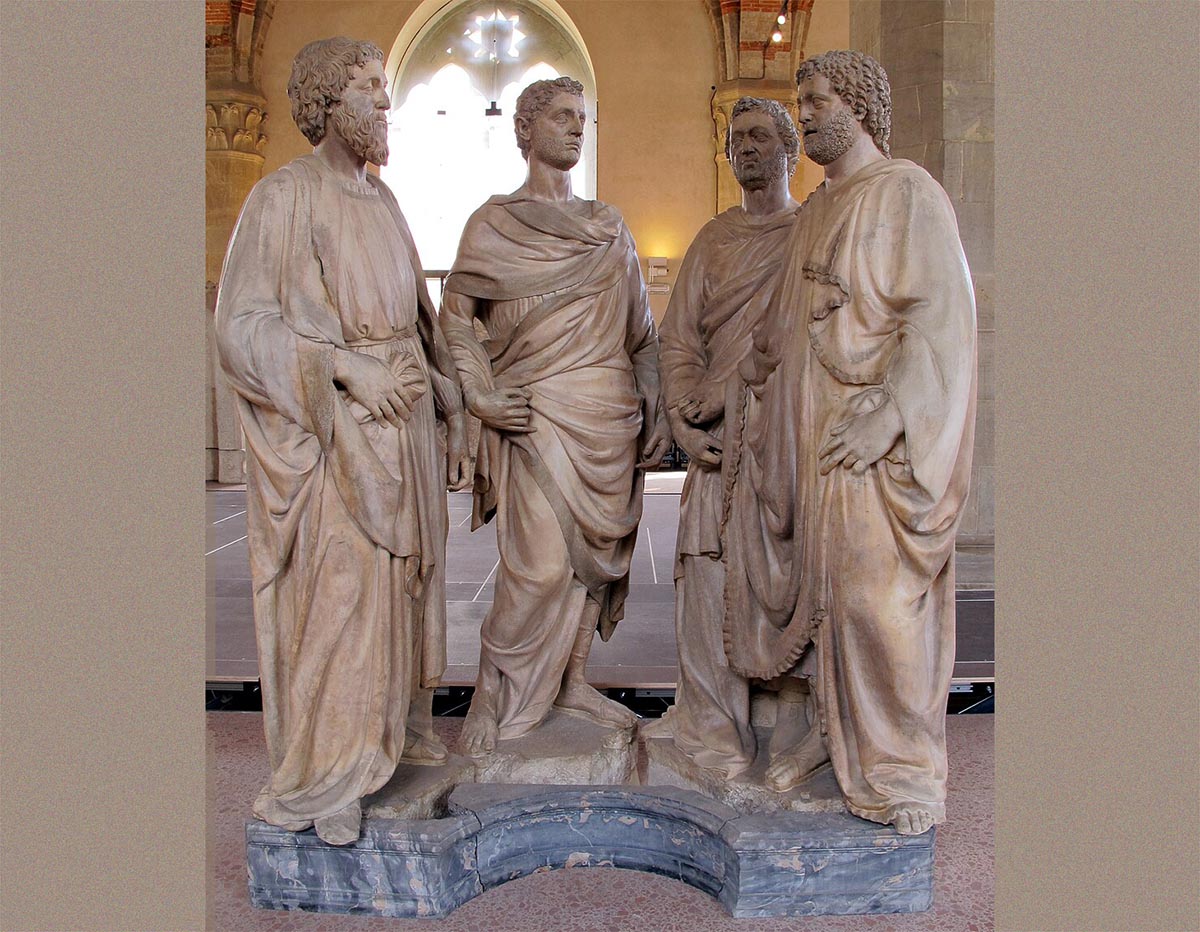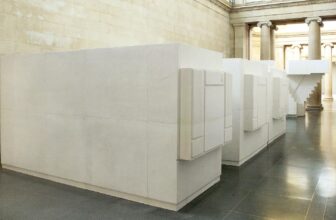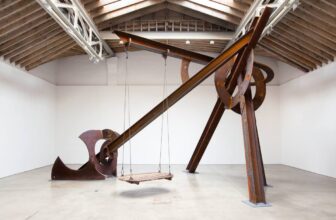
What Does the Four Crowned Saints Sculpture Represent
Nestled in the heart of Florence, on the exterior of the Church of Orsanmichele, four stone figures stand in quiet conversation. They are lifelike, majestic, and strangely modern for something carved over six centuries ago. These men, dressed in the garb of ancient Rome, seem frozen mid-discussion, as if they might continue speaking once the viewer turns away. This is Nanni di Banco’s “Four Crowned Saints”, one of the crowning achievements of early Renaissance sculpture, a moment when art, faith, and civic identity converged in perfect harmony.
This remarkable group, completed around 1410–1414, is more than just a masterpiece of stone carving. It is a statement of human dignity, moral courage, and the revival of classical ideals in Renaissance Italy. But to understand its meaning and significance, one must journey back to a time of both artistic revolution and deep spiritual reflection.
Who Was Nanni di Banco?
Nanni di Banco (c. 1384–1421) was a Florentine sculptor born into a family of stone carvers. He was a contemporary and sometimes rival of Donatello, and he stood at the transitional edge between the Gothic style of the Middle Ages and the classical revival of the Renaissance. Though often overshadowed by Donatello or Ghiberti, Nanni played a pivotal role in the transformation of sculpture from stiff medieval figures to lifelike, emotionally resonant characters.
Nanni’s importance lies in his ability to fuse classical Roman aesthetics with the new humanist ideals flourishing in Florence at the dawn of the 15th century. Nowhere is this more evident than in his most famous work, “The Four Crowned Saints”, or Quattro Santi Coronati.
The Setting: Orsanmichele
Before exploring the sculpture’s deeper meaning, it’s essential to understand its setting: Orsanmichele, a unique Florentine structure that was part church, part granary, and part civic symbol.
In the early 1400s, Florence’s powerful guilds, associations of craftsmen and merchants, were each assigned niches on the exterior of Orsanmichele to fill with statues of their patron saints. These sculptures were not just religious icons; they were public declarations of civic pride, artistic patronage, and the moral authority of the guilds.
Nanni di Banco was commissioned by the stone and woodworkers’ guild (Maestri di Pietra e Legname) to create a sculpture for their niche. The choice of subject was deeply symbolic and intensely personal.
Who Are the Four Crowned Saints?
The title “Four Crowned Saints” refers to a group of early Christian martyrs from the Roman Empire. According to legend, these men, Claudius, Nicostratus, Simphorian, and Castorius, were sculptors or craftsmen working during the reign of Emperor Diocletian (284–305 AD).
They were ordered to sculpt a pagan idol, but they refused on grounds of their Christian faith, choosing martyrdom over betraying their beliefs. For their defiance, they were executed, and their story was recorded in the medieval hagiography, The Golden Legend.
It’s no coincidence that the stoneworkers’ guild chose these saints as their patrons: they were sculptors who died for their integrity. By commissioning this sculpture, the guild was aligning itself with the highest virtues, faith, craftsmanship, and moral courage.
Art That Breathes: Description of the Sculpture
Nanni di Banco’s “Four Crowned Saints” is housed in an elegant gothic tabernacle, but the figures themselves are a profound departure from the Gothic style. Carved in marble, the group is depicted in the round, yet set within a shallow niche, a subtle blend of architectural framing and sculptural presence.
Rather than being isolated individuals, these four figures are arranged in a semi-circle, engaged in an apparent conversation. Their poses are natural, their expressions individualized, and their drapery is modeled with deep knowledge of Roman sculpture. Each man turns subtly to the other, creating a silent drama, not of action, but of thought.
They wear the robes of Roman senators or philosophers, tying them not to medieval saints but to the glory of antiquity. Their stoic expressions suggest calm rationality, dignity, and the weight of moral responsibility.
This was revolutionary.
At a time when most sculpture still followed the flat, frontal style of Gothic art, Nanni di Banco was introducing human psychology, individualism, and classical naturalism into public sculpture. These were not icons to be revered from afar, they were humans to be understood, to be emulated.
What Does the Sculpture Represent?
The “Four Crowned Saints” sculpture operates on several levels of representation:
1. Religious Devotion
At the simplest level, it is a religious tribute to Christian martyrs. The saints are honored for their refusal to compromise their faith, echoing the Christian ideal of martyrdom as the highest form of witness.
2. Moral Integrity
The sculpture also represents the moral responsibility of artists and craftsmen. It conveys the idea that work, especially artistic work, should serve truth and virtue, not power or idolatry. The saints’ refusal to create a false idol speaks to the guild’s self-conception as defenders of truth and justice.
3. Human Dignity
In portraying these men not as distant saints but as intelligent, engaged individuals, Nanni elevates the human spirit. This humanist approach mirrors the Florentine Renaissance ideals that every person is capable of reason, virtue, and greatness.
4. Civic Pride
Finally, the sculpture was a bold public statement. It declared the stoneworkers’ guild as essential to the fabric of Florence, guardians of both the city’s literal stones and its moral foundations.
Symbolism in the “Four Crowned Saints”
Symbolism in this sculpture is layered and nuanced, reflecting both religious and secular meanings:
● The Circle of Conversation
The semi-circular arrangement of the saints symbolizes intellectual exchange and communal decision-making. It evokes the Roman senate, the early Church councils, and the Florentine republic’s own ideals of shared governance.
● Classical Drapery
The deeply carved togas are symbolic not only of classical revival but of timeless wisdom. They align the saints with philosophers and lawmakers rather than with medieval ascetics, reinforcing the idea that faith is compatible with reason.
● Detached Self-Presence
Each figure appears lost in thought, and while they gesture slightly toward each other, they don’t directly engage the viewer. This creates a sense of internal dialogue, the struggle between duty, fear, and conscience.
● Sacrifice Without Drama
There are no signs of violence, suffering, or divine intervention. The calm demeanor of the saints suggests that true martyrdom is an inner victory, a serene commitment to principle, not a theatrical death.
● Complementary Relief Panel
Below the main group, Nanni also carved a low relief panel depicting sculptors at work. This is a rare instance of artists representing themselves, emphasizing the dignity and labor of craftsmanship. It acts as both a devotional image and a self-portrait of the guild’s role in society.
Why Is It Famous?
The “Four Crowned Saints” sculpture is famous for several key reasons:
✦ Pioneering Humanism in Sculpture
This work is among the earliest to show a naturalistic portrayal of human interaction, a stepping stone between medieval iconography and Renaissance realism. It foreshadowed the emotional realism later seen in Donatello and Michelangelo.
✦ Integration of Classical and Christian Themes
The seamless fusion of pagan aesthetics with Christian morality was revolutionary. Nanni reintroduced ancient Roman sculptural language while still honoring Christian values, a hallmark of Renaissance thought.
✦ Public Impact
Installed in a prominent niche in a central location, this was one of the first Renaissance sculptures seen by a wide public audience. It helped to redefine public art as a medium not just for devotion, but for education, inspiration, and identity.
✦ Guild Identity
It’s a visual manifesto of the stoneworkers’ pride, ethics, and contribution to Florence. In an era when art, politics, and religion were deeply intertwined, this sculpture spoke for an entire class of laborers and artists.
Where Is the “Four Crowned Saints” Sculpture Located?
The original sculpture is located in Florence, Italy, on the exterior of the Church of Orsanmichele, situated between Via dei Calzaiuoli and Via dell’Arte della Lana. However, to protect the original from weathering, it has since been moved indoors to the Museo di Orsanmichele, which occupies the upper floors of the church building.
A replica now occupies the original outdoor niche, allowing visitors to still experience the sculpture’s intended architectural context while preserving the delicate marble figures indoors.
Four Crowned Saints Legacy and Influence
Nanni di Banco’s “Four Crowned Saints” paved the way for a new kind of art, art that was not just decorative, but intellectual. It influenced generations of sculptors, including Donatello, Ghiberti, and later, Michelangelo, who expanded on the themes of human dignity and psychological depth.
More than that, it remains a living dialogue between past and present, an invitation to consider what we believe, what we stand for, and how we express those values through our work and our communities.
In the hushed stone dialogue of Nanni di Banco’s “Four Crowned Saints,” we hear echoes that transcend time. These figures, silent, immobile, and yet profoundly alive, speak not only of martyrdom and faith, but of integrity, craftsmanship, and the enduring power of human thought.
Their presence at Orsanmichele is more than decorative. It’s instructional, moral, and aspirational. It reminds us that art can do more than please the eye, it can shape the soul, question power, and honor the labor that builds civilizations.
They were sculptors who refused to carve a lie.
And in doing so, they, and Nanni, carved a truth that still speaks across six centuries.




